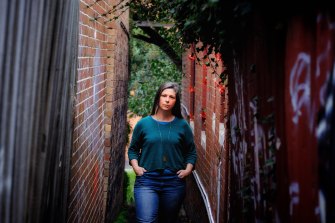Why change at the top will make women feel safer
One day last week, the front page of this newspaper published a gruelling catalogue of allegations of sexual harassment and misogyny made by Commander Donna Wheatley, the second-highest ranked woman in Victoria’s firefighting agency, Fire Rescue Victoria.
Wheatley has dedicated almost 20 years of her life to the agency before she succumbed to her mistreatment and could not go on. Since going public she has lodged legal proceedings seeking compensation for the loss of her career.

Commander Donna Wheatley, one of Victoria’s highest-ranking female firefighters, is calling out a culture of sexism.Credit:Luis Ascui
On that same morning, Prime Minister Scott Morrison fronted the National Summit on Women’s Safety. Morrison announced that, “We have to talk about the way some men think they own women â€" about the way some women are subject to disrespect, coercion and violence.â€
The effect of the Prime Minister solemnly uttering those words was a collective eye roll of many summit participants that it almost generated a seismic tremor.
One month later, Brittany Higgins came forward to allege that she had been raped by a Morrison government staffer in a ministerial office. The Prime Minister refused to ask his staff to divulge what they knew about it and when. He commissioned his former adviser, Phil Gaetjens, to conduct an investigation which may never be finalised.

Brittany Higgins speaks at the March 4 Justice protest outside of Parliament House in Canberra.Credit:Dominic Lorrimer
Morrison may be calculating that most Australians have a very short attention span, don’t care enough about women’s safety or that they are otherwise distracted by the dislocation unleashed by the coronavirus pandemic.
While the federal government systematically refuses to address gender inequality, the problem is so entrenched and systemic that more confronting sexual misconduct scandals will emerge.
We have long known about misogyny and sexual harassment in Victoria’s firefighting ranks. The senior member of the CFA stood down for allegedly filming female co-workers getting changed in 2018; the CFA report on Gender Diversity and Inclusion, which found rampant bullying, sexual harassment and the existence of a boys’ club culture that protected its own; the now suppressed Victorian Human Rights commission report into the MFB which reportedly detailed an entrenched culture of bullying and sexual harassment.
Women make up about 5 per cent of operational roles in Fire Rescue Victoria, a figure that compares badly to interstate firefighting agencies and other emergency services including Victoria Police.
Similar sexual harassment scandals have dogged Airservices Australia, another male-dominated command and control environment that employs air traffic controllers. But the problem is much bigger.
Addressing sexual harassment and other violence against women starts with recognising that it is a systemic problem.
Recent events have confirmed that women are not safe working in the federal parliament. Nor are they safe in the courts that administer our laws, including laws proscribing sexual harassment.
Women are not safe when they go to work for some of our major corporations as recent scandals at AMP and BHP have demonstrated.
Women are not safe in workplaces in which older men occupy the senior positions in the hierarchy and younger women work in more junior roles.
That’s most of our workplaces.
Addressing sexual harassment and other violence against women starts with recognising that it is a systemic problem reflecting gender inequality that dogs us from cradle to grave. It is so entrenched in our lives that it has been resistant to decades of anti-discrimination laws, inquiries, reviews, policies and training.
In fact, we are going backwards. Australia has fallen from 15th to 44th on the World Economic Forum Global Gender Gap Index in the last decade.
The cure requires far more ambition than we dare to acknowledge; a fundamental structural change to the roles of men and women both at and outside work.
Consider Fire Rescue Victoria. Women like Donna Wheatley will only start to feel safe at work when both the senior and operational ranks of the organisation are occupied by both men and women.
Secondly, when male firefighters routinely access six months’ parental leave after the birth of a child. The current barriers that prevent such change need to be dismantled.
If there is a conversation left to be had, it is about how to transform the gender distribution of roles occupied by men and women in Australia.
Josh Bornstein is a lawyer and writer. He is representing Commander Donna Wheatley in her sexual harassment claim.
Josh Bornstein is head of Maurice Blackburn's national Employment Law department and is a member of the company's board.Connect via email.
0 Response to "Why change at the top will make women feel safer"
Post a Comment